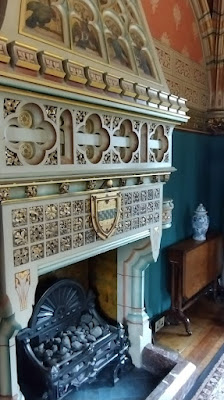After our usual morning cappuccinos/coffees at KIN+ILK, we walked through lush Sophia Gardens and Bute Park on a sunny morning to Fabulous Welsh Cakes for their freshly grilled specialty.
Welsh Cakes taste like a sweet combination of a pancake and biscuit, and Fabulous offers an interesting array of flavors
We all loved these delicious breakfast treats. Libby bought a cookbook dedicated to Welsh Cakes as a souvenir at another store during the trip and so she can make them at home.
A short walk across the street from Fabulous Welsh Cakes is Cardiff Castle.
The stone Medieval fortress sits in a strategic location for military purposes.
Romans built a fort on the site in about 55 BC. In those days, the fortress overlooked an ocean harbor, as do many former Roman forts built on seacoasts during the warm era during which the original empire based in Rome prospered.
Over the centuries, improvements in building and military technology transformed the original wooden fort into the massive stone castle grounds of Medieval times that we enjoyed visiting.
The motte-and-bailey --- with "motte" meaning an elevated mound and "bailey" a walled courtyard, surrounded by a moat --- castle of stone was completed in about 1080, so just before the First Crusade. The completed structure we saw on our visit is from about 1430.
As with any home, furnishings in the residential area changed over the decades, and much of what we saw was from a rather elegant era from the mid-18th through the earliest 20th centuries, I believe, with some older art objects and other touches.
As you can see in the artwork, it has all been beautifully conserved.
The audio tour told the stories of different royals who inhabited the castle and legends or history behind various artwork.
Cardiff Castle was used as an air raid shelter in World War II when Cardiff was the target for over 2,000 bombs, and there is a section of the wall dedicated to telling that story.
It is that magic of the days of King Arthur through Medieval times with knights in shining armor that seems embodied in the castle structure, and other than possibly Glastonbury, no other place in the British Isles seems more connected to Arthurian legend as Wales to me.
Along the lines of legends about knights, when hiking in Wales, I sometimes heard wind howling through the trees in the distance, creating what sounded like growling monsters. Odd, because the wind wasn't that strong on the trails, but it made me realize how ignorant people in much earlier times might've believed there were dragons in those woods.
As to whether that illusion would have been used to scare invaders, or at least make them think twice about pushing forward, I don't know, but the power of suggestion can definitely change how even educated, modern individuals and like-minded groups interpret natural phenomenon to create fear that political leaders find useful.
Certainly, American troops in Iraq unleashed the dragons and demons of heavy metal blaring from speakers before launching their attack in order to create fear.
In any case, the flag of Wales features a fierce red dragon over the green and white colors of the Tudors.
The image of the dragon has been used by Wales for many centuries. It was mentioned in Historia Brittonum in the year 828 and had likely been around long before then. It was supposed to signify independence while alluding to a link back to King Arthur.
As an aside significant to my family, I will note that Drexel University's logo prominently features a dragon. Drexel's team name is Dragons. Gina and Laszlo work at Drexel University in Philadelphia. I often wear my Drexel Dragon hat featuring the golden dragon logo on hikes, though Julie says it has now gotten too faded to wear (is there such a phenomenon?).
As I say, the red dragon similar to the gold one on my hat is on the flag of the entire country of Wales, not just Cardiff.
And Cardiff Castle is not the only castle in Wales.
Far from it.
Wales has more castles per square mile than anywhere on Earth, primarily because of the Norman Invasion.
The Normans conquered England rather efficiently beginning in the year 1066, an event that is one of the most significant in human history for what has unfolded since then.
By about 1200, the Normans --- or by that point should they simply be called the English? --- redoubled efforts to invade Wales, a country that had been hardened by fighting off Vikings for centuries leading to this new invasion from England.
The Welsh had defensive castles, and the Normans built offensive castles. The conquest of Wales took over 200 years, so there were lots of opportunities for valor and chivalry that could be celebrated behind thick castle walls in between battles, I imagine.
We were all won over by the castle, which at first glance seemed to have given into modern commercialism with a concert stage and various supporting food vendors set up on the grounds.
Libby bought some posters of family tree stories for the names of her parental surnames and her married name at one of the booths.
While castles continued to be status symbols and royal sanctums, their true military significance declined beginning with The Battle of Crecy in 1346.
From the English introduction of those primitive guns and longbows, offensive weapons that could kill from afar with ever more devastating and deadly force became the key to winning battles rather than defensive strongholds like castles.
Explosives made it possible to breach what had before been impenetrable walls, and the rest, as they say, is history.

.jpg)














































No comments:
Post a Comment